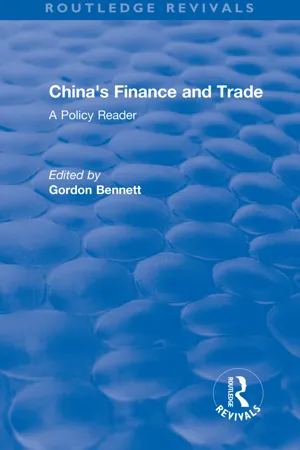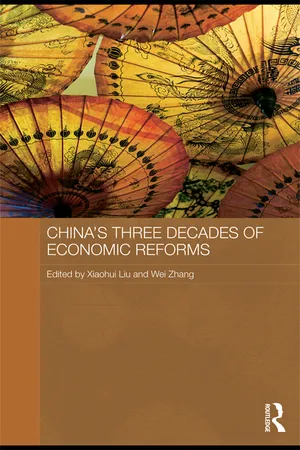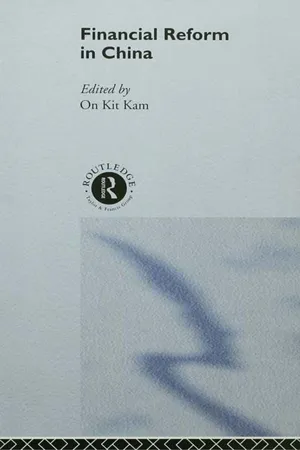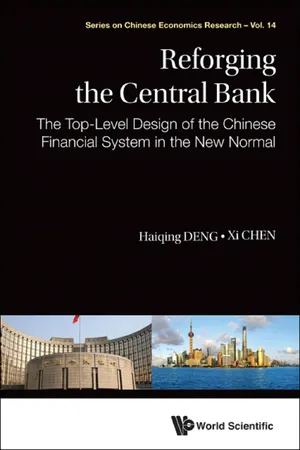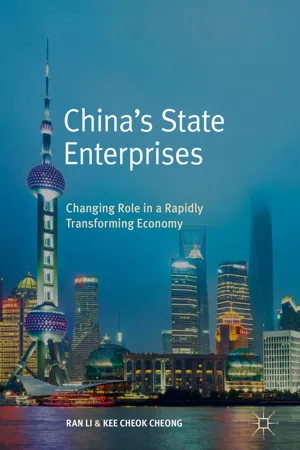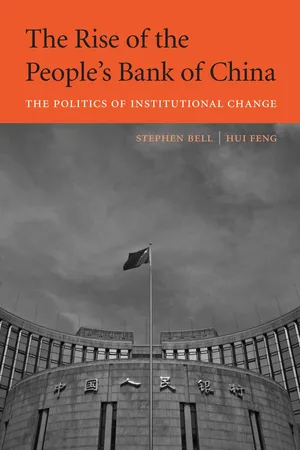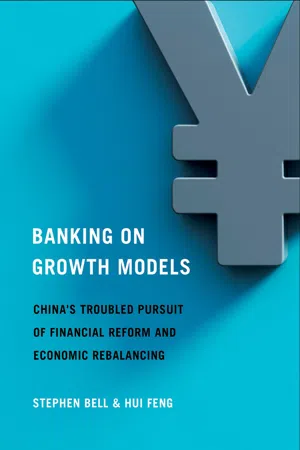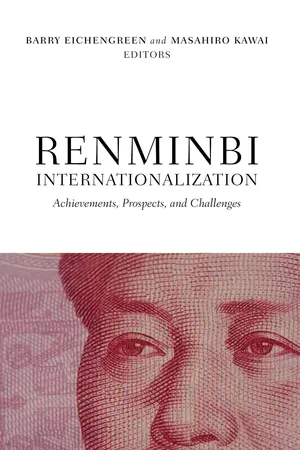Economics
People's Bank of China
The People's Bank of China is the central bank of the People's Republic of China. It is responsible for formulating and implementing monetary policy, issuing the national currency (renminbi), regulating financial institutions, and maintaining financial stability. As the primary financial authority in China, the People's Bank of China plays a crucial role in the country's economic management and development.
Written by Perlego with AI-assistance
Related key terms
9 Key excerpts on "People's Bank of China"
- eBook - ePub
Reival: China's Finance and Trade: A Policy Reader (1978)
A Policy Reader
- Gordon A. Bennett(Author)
- 2017(Publication Date)
- Routledge(Publisher)
In its capacity as the state bank, the People's Bank keeps the accounts of the public administrations. It centralizes tax resources and deposits of the nationalized organizations. However, the bank is not in charge of debt recovery, which is the responsibility of the specialized administrative services.One of the important tasks of the bank is also to ensure correct commercial practices. In this respect, it plays the role of our clearing houses and our centers for postal checks. As indicated above, all sales by the nationalized industries have to be paid by transfer, and only salaries and certain purchases by commercial firms of agricultural goods for communes are settled in cash. Thus 85 percent of bank transactions take the form of transfers from account to account, the remainder being made up of withdrawals or deposits of notes.The Economic Functions Exercised by the People's Bank
One of the goals pursued consistently by Chinese monetary policy seems to be a search for adapting solvency to the quantity of available goods. The adjustment of the offer of cash is accomplished, on the one hand, by a detailed examination of demands for business credit and, on the other hand, by systematic encouragement of individual savings.When studying a credit, the People's Bank rigorously controls the financial situation of the industry and the profitability of expected expenses. It sees to it that all sales have been settled, that the withheld liquidities do not exceed the budget, and that previously accorded credits have been used effectively. Expenses which produce treasury needs are subsequently carefully examined, with the bank advising the industry on the profitability of the planned transactions and the technical and financial means of achieving the most economical solutions. When the expenditures do not correspond to forecasts, the bank can demand immediate reimbursement of the agreed credits.Thus, the process of control of the bank can lead it to the exercise of too strong a control over the operations of industry. Since the Cultural Revolution, and particularly since 1970, the emphasis in articles published in the Chinese press has largely been on the role of administrative advisers that bank employees should assume. (8 - eBook - ePub
- Xiaohui Liu, Wei Zhang(Authors)
- 2009(Publication Date)
- Routledge(Publisher)
It was clearly stated that ‘the central bank, the People’s Bank of China, under the leadership of the State Council, should implement monetary policy independently’. The independent status was further elucidated in that ‘the power of the central bank and local authorities over economic administration should be rationally delineated’ and ‘the branches of the People’s Bank of China are certified as agencies of its head office’. 2 To put the decision into practice, a Law of the People’s Republic of China on the People’s Bank of China (PBCL) was enacted in 1995. The PBCL established a legal foundation for the superior status of the PBC by stipulating that under the leadership of the State Council, the PBOC devises and implements monetary policy and monitors the operations of the financial sector (Article 2). Article 7 of the PBCL entrusts the PBOC with a high level of independence by specifying that the PBOC is free from the intervention of local governments, government departments, organisations and individuals when it performs its central bank and business functions. To enhance the profitability of the banks, the Chinese authorities also endorsed, in the Third Plenum of the 14th Central Committee, separating policy lending from commercial lending. By this, the four SBs would gradually be transformed into SOCBs. Policy-based loans are designated to the three policy lending banks that were established in 1994. 3 China’s banking reform in 1994, which aimed at commercialising the four SOCBs 4 by separating commercial lending from policy lending, unintentionally resulted in noticeable capital constraints facing the small and medium-sized private enterprises, particularly those in rural areas. Since the SOCBs were required to operate on commercial principles, 44,000 county branches of SOCBs ceased to operate during 1998–2001 to cut the operation costs - eBook - ePub
- On Kit Tam(Author)
- 2013(Publication Date)
- Routledge(Publisher)
After 1979, one by one, the Bank of China, the People’s Construction Bank of China and the Insurance Company became independent economic bodies under the direct leadership of the State Council. Later, the Agricultural Bank of China, the Industrial and Commercial Bank of China, the Bank of Communications, the China International Trust and Investment Corporation, the China New Technologies Investment Company and other financial institutions were established. From 1 January 1984 the People’s Bank of China ceased to handle general industrial and commercial credit and savings and became the Central Bank of China.Over the past ten years, apart from financial institutions establishedFigure 5.1 China’s financial institutionswith state capital, other financial organisations have been set up. These include financial trust companies, negotiable securities companies and financial companies funded by local government and enterprises. There are also rural credit co-operatives funded through equity shares by farmers, and urban credit co-operatives funded by private entrepreneurs in the towns, by collective enterprises and even state units. Figure 5.1 presents a schematic structure of China’s financial system. By the end of 1990, China had more than 181,000 financial institutions, with the state specialised banks as the mainstay under the leadership of the central bank.1 THE REFORM OF CHINA’S FINANCIAL INSTITUTIONS
China’s financial institutions have undergone many important changes since the reform.1.1 China’s financial institutions now have autonomy in the utilisation of funds
Prior to the reform, all domestic credit transactions were handled through the People’s Bank of China. Branches of the People’s Bank had no autonomy in granting credit. The People’s Bank handed down through the credit plan for the branches the sum total of credit, as well as plans for credits according to items. Industrial credit, commercial credit and agricultural credit all had specific quotas. No adjustment or exchange between the various quotas were allowed, earmarked funds were to be used for stipulated purposes. The head office’s management of its branches was extremely rigid.After the People’s Bank of China became the central bank in 1984 it strictly delineated its financial relationship with the various specialised banks. A deposit reserve system was established. The specialised banks under the new management system developed business mainly by relying upon their own ability to attract savings, and when there were insufficient deposits they could borrow from the People’s Bank. Every year the People’s Bank would hand down its lending quota on fixed assets to the specialised banks, and within these limits any extra deposits they received would allow them to extend additional loans. The People’s Bank did not make any rules regarding the direction of loans and within the scale announced in its annual credit policy the specialised banks had autonomy in the utilisation of funds. - eBook - ePub
The Chinese Macroeconomy and Financial System
A U.S. Perspective
- Ronald M Schramm(Author)
- 2015(Publication Date)
- Routledge(Publisher)
The PBC utilizes a wider range of available tools for the conduct of monetary policy compared to the Fed. While the Fed relies primarily on open market operations to affect the federal funds rate, the PBC makes substantial use of other tools that we have described. By the end of 2012, however, the PBC had moved to a heavier reliance on open market operations.One important reason why China relies on a wider arsenal of monetary policy tools is related to the complexity of tasks undertaken. Keeping a fixed (or “crawling peg”) regime in place while at the same time controlling the money supply to curb inflation and manage economic growth requires controlling the flow of international capital (as we discuss in Chapters 3 and 8 ). Notwithstanding a sophisticated set of capital controls, China cannot let its interest rates stray too far from international rates lest the wall of capital controls be breached. This basic paradox creates a need for intervention in the economy at a variety of levels. How long China can maintain its balance in trying to achieve so many goals remains to be seen.Case Study 7.5: China’s “Big Four” Banks
China’s largest four banks now rival the largest U.S. banks and are among the largest banks in the world as measured by assets (see Tables CS7.5a and CS7.5b). At one level, this is unremarkable given China’s enormous savings rate and limited alternative asset classes. It is remarkable because these banks were, until the late 1980s, not recognizable as independent entities but rather entities operating under the wing of either the Ministry of Finance or the PBC. All banks in China were among the first institutions to be nationalized after the founding of the PRC in 1949. Even today, the majority of shares in these institutions are owned by the government. For example, over 70 percent of Bank of China shares are state owned. Beginning in the 1980s, however, these banks gained increasing independence from direct government control, were allowed to accept individual deposits, and between 2000 and 2010 had each issued shares (IPOs) on domestic and international stock exchanges with small minority ownership. - eBook - ePub
Reforging The Central Bank: The Top-level Design Of The Chinese Financial System In The New Normal
The Top-Level Design of the Chinese Financial System in the New Normal
- Haiqing Deng, Xi Chen(Authors)
- 2016(Publication Date)
- WSPC(Publisher)
The role of China’s central bank in macroeconomic control has also undergone changes. In the 1990s, when market reform was one of the government’s priorities, the relation between the government and the market changed for the first time. In 1993, the State Council released the Decision of the State Council on the Reform of the Financial System, stating that one of the goals of the financial structure reform is “to set up a macroeconomic-regulatory system of the central bank that implements independently the monetary policy under the leadership of the State Council.” In the same year, Zhu Rongji, the then Vice Premier of the State Council, took the office of governor of the People’s Bank of China, giving the bank more independency. Hu–Wen Administration emphasized the role of the government, giving less play to the market. The NDRC was put at the helm of macroeconomic control with clear marks of planned economy while PBOC’s monetary policy was only a supplement with dwindling independency. In 2013, Decision of the CCCPC on Some Major Issues Concerning Comprehensively Deepening the Reform of the third Plenary Session of the 18th CPC Central Committee declares “the market should play a decisive role in allocating resources.” One of the primary conditions for this is less intervention from the government. Since then, taking steps to streamline administration and delegate power has been a key measure of the new administration to boost economy. Accordingly, the central bank has enjoyed more prominence in the top design of the nation. The liberalization of interest rate and exchange rate accelerates; new monetary tools keep emerging; monetary policy has even been introduced into the reform of industrial structure, a former territory of fiscal policy. It should also be noted that Zhou was elected Vice Chairman of CPPCC, a sub-national leader just as Zhu in the late 1990s - eBook - ePub
China's State Enterprises
Changing Role in a Rapidly Transforming Economy
- Ran Li, Kee Cheok Cheong(Authors)
- 2018(Publication Date)
- Palgrave Macmillan(Publisher)
Qing Dynasty and the post-revolutionary period before the outbreak of the Second World War, when successive governments tried but failed to control the financial sector and currency system to manage the economy. The result has been frequent changes and policy reversals in the quest to form a central bank, control of currency, and financially manage the economy, with policies held hostage to political rivalry and leadership struggles. The role of foreign interests, be they states or private financial enterprises, in furthering their own interests (as demonstrated by HSBC) in or at the expense of (as shown by Roosevelt’s silver purchases) China’s financial system, and Chinese reliance on them to bolster the latter must have been another lesson not lost on later generations of the Chinese leadership.Second, the central role of the state as a political philosophy, which is also rooted in China’s culture and history as discussed in Chap. 2 , calls for banks to be major instruments of Chinese policy under its state-led model. This means banks are called upon in extraordinary situations when the stability of the economy is threatened and when the state seeks to advance its interests beyond its borders. This role can clearly be seen when the GFC hit China in 2008–2009 and when the Chinese government sought membership in the WTO to increase its international footprint.At the same time, the government is aware of the inefficiencies associated with not privatizing these banking institutions. It has attempted modernizing their governance , strengthening efficiency, and distancing them from the central government in their day-to-day operations, which has resulted in their operating like and fulfilling the role of commercial banks in the country’s financial system. It has however also accorded them preferential treatment.With state protection, they are performing well, perhaps to the detriment of truly private banks. China is pursuing and its leadership is clearly aware of the transitional costs of the state role in banking for the development of a private banking sector, which is consonant with the state-led growth model. However, they must feel this cost is outweighed by what they believe to be the benefit from being able to use banks to support and implement state functions in ways that Western commercial banks have not or could not. China’s enormous pool of external reserves undoubtedly gives the government comfort in managing whatever costs such a system may engender. Therefore, it is likely that the Chinese state will live with the costs for as long as the state-led growth is pursued and as long as these banks continue to be perceived as effective instruments of policy. - eBook - ePub
- Stephen Bell(Author)
- 2013(Publication Date)
- Harvard University Press(Publisher)
Hence, despite substantial inertia and resistance, the key role of the PBC in building a modern financial infrastructure is significant. Through Huijin, the Chinese central bank drew on 10% of the foreign reserves and controlled more than half of the state’s financial assets, which enabled substantial financial reforms following the PBC’s own liberal agenda. The reforms, which aimed at weakening the central state’s dominance in the (distorted) market and transforming the domestic financial intermediaries into more market-oriented commercial institutions, have helped reassure international investors regarding China’s banking reforms. However, there are problems with this model, especially continued state intervention in the banking sector under the control of a more conservative MOF, and the bailout of securities companies that are owned by central and local governments, which could generate moral hazard. Overall, however, the PBC’s efforts have thus far laid a more solid foundation for China’s financial stability and development in a post-WTO era. Further substantial reforms are, however, required.Passage contains an image 12 Conclusion
During an interview, a PBC official gave a vivid analogy of the politics of reform amidst transition, and the complex institutional challenges it entails: “China is very much like a giant leaking ship. We cannot stop and repair the ship, otherwise it is bound to sink. We have to mend it while it sails until reaching the shore. In other words, we have to reform amidst development, and to develop amidst reform. There is no other alternative.”1 - eBook - ePub
Banking on Growth Models
China's Troubled Pursuit of Financial Reform and Economic Rebalancing
- Stephen Bell, Hui Feng(Authors)
- 2022(Publication Date)
- Cornell University Press(Publisher)
2INTERESTS, IDEAS, INSTITUTIONS, AND THE POLITICS OF BANKING AND ECONOMIC REFORM IN CHINA
The fate of China’s financial and banking system and that of its wider economy and growth model are intertwined and reflect complex political processes of institutional change shaped by changing power dynamics among key agents. In this chapter we focus on the interests and behavior of our key agents shaping change. The most powerful of these are within the party leadership, in the banking system, in the state sector, and in a range of government bureaucracies, including reformist agencies such as the People’s Bank of China (PBC). Weaker actors include borrowers in the household and private sectors who succeeded, for a period, in gaining substantial flows of credit from the shadow banking sector after the GFC. For the most part, however, households and the private sector have been co-opted or repressed due to the authoritarian nature of the Chinese state and its controls over the economy and society (Dickson 2008). This chapter introduces the actors in our story, and their interests, motives, and relative powers, and outlines the nature of the institutional and political dynamics in which they operate.Key Actors and Agendas within the Party-State
Our key agents are often able to exploit opportunities and institutional and political resources that enable them to effect political and institutional changes in the growth model. Given the hierarchical and authoritarian nature of China’s political regime and its control over critical financial resources, the key actors involved have been policy elites, particularly political leaders and senior bureaucrats from the Communist Party and relevant institutions within the central government in Beijing and in local governments. Despite the predominance of the central state in China, local governments have also been significant players in growth-model and financial change. - eBook - ePub
Renminbi Internationalization
Achievements, Prospects, and Challenges
- Barry Eichengreen, Masahiro Kawai(Authors)
- 2015(Publication Date)
- Brookings Institution Press and ADBI(Publisher)
PART IVThe View from the People's Republic of China
Passage contains an image
10
Paths to a Reserve Currency: Renminbi Internationalization and Its Implications
YIPING HUANG, DAILI WANG, AND FAN GANGAround mid-2008 at the height of the global financial crisis, the People's Bank of China (PBOC) made two important decisions with regard to its currency policy: one was to significantly narrow the trading band of the renminbi–U.S. dollar exchange rate and the other was to promote the international use of the renminbi (RMB) in trade settlement, especially trade with neighboring economies. The former was similar to what the PBOC did during the Asian financial crisis to stabilize investors’ currency expectations. The latter, however, was likely motivated by the ambition to make the RMB an international currency.Many policymakers in the People's Republic of China (PRC) believe that the international monetary system dominated by a national currency, the U.S. dollar, is logically inconsistent and unsustainable. The outbreak of the subprime crisis in the United States was evidence of the problem. A possible long-term solution is to create a supranational currency, such as a revamped special drawing right (SDR) of the International Monetary Fund (IMF) (see, for example, Zhou 2009). In the short run, however, the subprime crisis could lead to weakening demand for the U.S. dollar and create room for the RMB to play some kind of international role.Although policies to internationalize the RMB picked up the pace in late 2008, in fact, the People's Bank of China's planning of this effort started much earlier. In 2006, a study group of the PBOC, the central bank, published an article titled “The Timing, Path and Strategies of RMB Internationalization,” in which it argued that “the time has come for promotion of the internationalization of the RMB” (People's Bank of China Study Group 2006). The study group also suggested that internationalization of the RMB could enhance the PRC's international status and competitiveness and would increase the country's influence in the world economy.
Learn about this page
Index pages curate the most relevant extracts from our library of academic textbooks. They’ve been created using an in-house natural language model (NLM), each adding context and meaning to key research topics.
